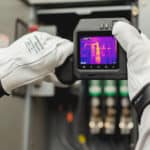If you eliminate non-injury incidents, you lessen fatal and serious injuries (FSI’s). That’s the theory behind well-known safety scholars like Herbert William Heinrich and Frank E. Bird, which is still being followed in many of today’s safety environments. The problem with this theory is that it is significantly flawed, especially when applied to energized asset management. In our latest white paper, Follow the Energy: One Factor Above All Defines Fatality and Serious Injury Causation – And Spots It in Advance, we discuss what’s wrong with the Heinrich-Bird accident pyramid and why a different strategy is needed to reduce serious injuries and fatalities in electrical safety. Read the overview of the white paper below and learn the best practices for FSI prevention when you download the full version here.
Why FSI’s Require Distinct Reduction Strategies
When working towards a safety goal of zero, almost all organizations continue to have just one initiative – one that is likely to reduce slips, trips, falls, cuts, contusions, and sprains. Yet, no progress is being made toward preventing the worst incidents. It’s because of Heinrich’s and Bird’s pyramids that this initiative is common in many safety environments and why organizations are so adept at preventing less severe injuries.
While Heinrich’s and Bird’s work do play a positive role in helping organizations mitigate incidents, there is a drawback to highly focusing on near misses and minor incidents. Working primarily at the bottom of the accident pyramid leaves organizations vulnerable to more serious events, which contrary to belief, are not random and, in fact, predictable and avoidable with sufficient reliability and maintenance programs. SEAM Group’s white paper dispels the beliefs that FSI’s are freak accidents and ascertains that each FSI has a root cause, and therefore, are not chance events.
By developing targeted strategies and using sophisticated data collection systems, organizations can identify if an FSI is influenced by materials, equipment, facilities, humans, or energy. With this information, organizations can have a better understanding of why FSI’s happen, increase the level of their predictability, and have a mitigation plan in place for ongoing prevention.
Properly Predict and Prevent FSI’s in Your Organization
Nearly every serious injury and fatality is predictable and within the scope of a rigorous, risk-based, systemic approach. Knowing this, organizations can develop strategies at the leadership level for preventing FSI’s and train electrical safety workers to ensure no one gets seriously injured or hurt. If you’re an organizational leader who needs guidance on predicting and preventing FSI’s, download our latest paper to get started.
In this white paper, we discuss:
- The Heinrich-Bird accident pyramid and why it doesn’t work in electrical safety
- Why developing a different strategy for reducing FSI’s is needed
- Real-life scenarios that illustrate FSI predictability
- Human factors and their influence on safe work performance
- Eight steps for FSI prevention to ensure workers avoid high levels of energy
When organizations are able to protect their workers from incidents, no matter where they fall on a pyramid, every level of performance improves.





